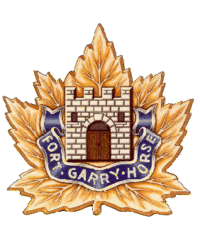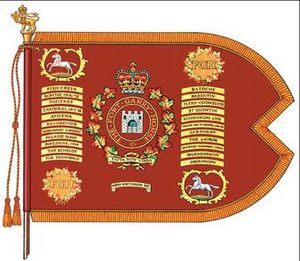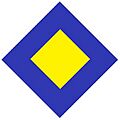The Fort Garry Horse facts for kids
Quick facts for kids The Fort Garry Horse |
|
|---|---|

The Fort Garry Horse badge
|
|
| Active | 1912 to present |
| Country | Canada |
| Branch | Canadian Army |
| Type | Line cavalry |
| Role | Reconnaissance |
| Part of | 38 Canadian Brigade Group |
| Garrison/HQ | McGregor Armoury, 551 Machray Avenue, Winnipeg |
| Nickname(s) | The Garrys |
| Motto(s) | Latin: facta non verba, lit. 'deeds, not words' |
| March | El Abanico (quick), Red River Valley (slow), alternate quick march: St. Patrick's Day |
| Insignia | |
| NATO Map Symbol |  |
| Abbreviation | FGH |
The Fort Garry Horse, often called 'The Garrys,' is a special army group in Canada. They are an armoured regiment, which means they use tanks and other strong vehicles. This group is part of the Canadian Army Reserve, made up of soldiers who train part-time. Their home base is in Winnipeg, Manitoba. The Fort Garry Horse helps the Canadian Army by doing reconnaissance, which means scouting ahead to gather information.
Contents
The History of The Fort Garry Horse
The Fort Garry Horse has a long and interesting history, starting over 100 years ago.
How the Regiment Started
The Fort Garry Horse began in Winnipeg, Manitoba, on April 15, 1912. It was first known as the 34th Regiment of Cavalry. A year later, on January 2, 1913, its name changed to the 34th Fort Garry Horse. After the First World War, on March 15, 1920, it became simply The Fort Garry Horse.
Joining Forces with The Manitoba Horse
On December 15, 1936, The Fort Garry Horse joined with another group called The Manitoba Horse. The Manitoba Horse had started in Roblin, Manitoba, on April 1, 1912. It was first called the 32nd Light Horse. This joining made the regiment even stronger.
The Fort Garry Horse in the World Wars
During the Second World War, the regiment was called into full-time service. It was known as the 10th Canadian Armoured Regiment (Fort Garry Horse). While some soldiers went overseas, another part of the regiment stayed in Canada. This group was called the 2nd Regiment, the Fort Garry Horse.
Changes After the Wars
After the Second World War, the regiment's name changed a few more times. It was known as the 10th Armoured Regiment (The Fort Garry Horse) and then The Fort Garry Horse. In 1958, a full-time part of the regiment, called the 1st Fort Garry Horse, was created. This group served in Canada, Germany, and on United Nations missions. However, this full-time part was later closed down in 1970.
Engineers Join the Team
In 2003, the regiment started helping to create a new group of Canadian Military Engineers. By 2012, this engineer group became its own unit, called 31 Engineer Squadron. For a while, these engineers wore the black beret of the Armoured Corps. Now, they wear the green beret, like other engineer units.
Vehicles Used by The Garrys
Today, The Fort Garry Horse uses modern vehicles for their scouting missions. These include the Mercedes Benz G-Wagon LUVW scout cars. They also use the Tactical Armoured Patrol Vehicle (TAPV).
Important Battles and Honors
The Fort Garry Horse has a proud history of serving Canada in many conflicts. They have earned special "battle honours" for their bravery. These honours are like awards for fighting in important battles.
North West Rebellion (1885)
The regiment's history includes a group called Boulton's Mounted Infantry. They were part of the North-West Rebellion in 1885. They helped in battles like:
The First World War (1914-1918)
During the First World War, soldiers from the Fort Garry Horse served in Europe. They were part of the Canadian Cavalry Brigade. One soldier, Harcus Strachan, even won the Victoria Cross, Canada's highest award for bravery, at the Battle of Cambrai in 1917. Some of their battle honours include:
- Somme 1916, '18
- Bazentin
- Pozières
- Flers-Courcelette
- Cambrai 1917, '18
- Amiens
- France and Flanders, 1916–18
The Second World War (1939-1945)
The Fort Garry Horse played a big role in the Second World War. They landed in Normandy, France, on D-Day, June 6, 1944. They fought across North-West Europe until the war ended. Their battle honours from this war include:
- Normandy Landing
- Carpiquet
- Falaise Road
- The Laison
- Boulogne, 1944
- Antwerp-Turnhout Canal
- The Scheldt
- Woensdrecht
- The Hochwald
- Groningen
- North-West Europe 1944–1945
War in Afghanistan
More recently, the regiment also earned a battle honour for their service in Afghanistan.
- Afghanistan
Regimental Symbols and Memorials
The Fort Garry Horse has several important symbols and places that honor its history and the soldiers who served.
The Guidon
The regiment has a special flag called a guidon. This guidon has the regiment's battle honours written on it. One guidon is displayed in the Manitoba Legislative Building. Another is still used by the regiment today.
The Armoury Building
The home of The Fort Garry Horse is called Lieutenant-Colonel Harcus Strachan, VC, MC Armoury. It's in Winnipeg, Manitoba. This historic building was built in 1914-1915 and is a recognized heritage site.
Memorial Wall
Inside the Armoury, there is a special memorial wall. It was dedicated in 1995 to remember all the members of the Fort Garry Horse who died while serving. The wall shows their battle honours, names, and the regiment's motto.
Monuments in France
In France, there is a monument in Masnières. It was unveiled in 2004 to remember the brave actions of the regiment during the Battle of Cambrai in 1917. This is where Harcus Strachan earned his Victoria Cross.
Plaques and Windows
Several plaques honor the regiment's role in liberating the Netherlands in 1944-45 and their landing on the beaches of Normandy on D-Day. Stained glass windows from a church in Germany were also brought to Winnipeg to remember the regiment's service in Europe.
Historic Vehicles on Display
Outside the Armoury, you can see some of the vehicles the regiment used in the past. These include a Lynx reconnaissance vehicle and a Sherman M4A2 tank.
Alliances
The Fort Garry Horse has a special friendship with a British army group:
 United Kingdom - The Royal Dragoon Guards
United Kingdom - The Royal Dragoon Guards
Images for kids




